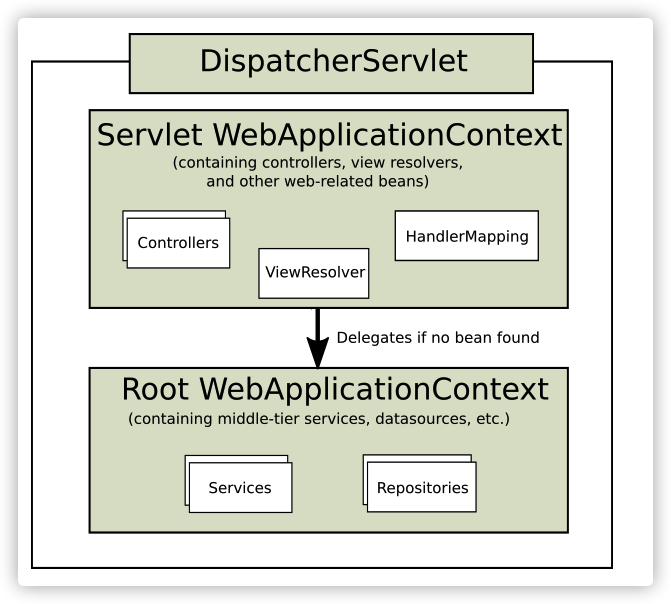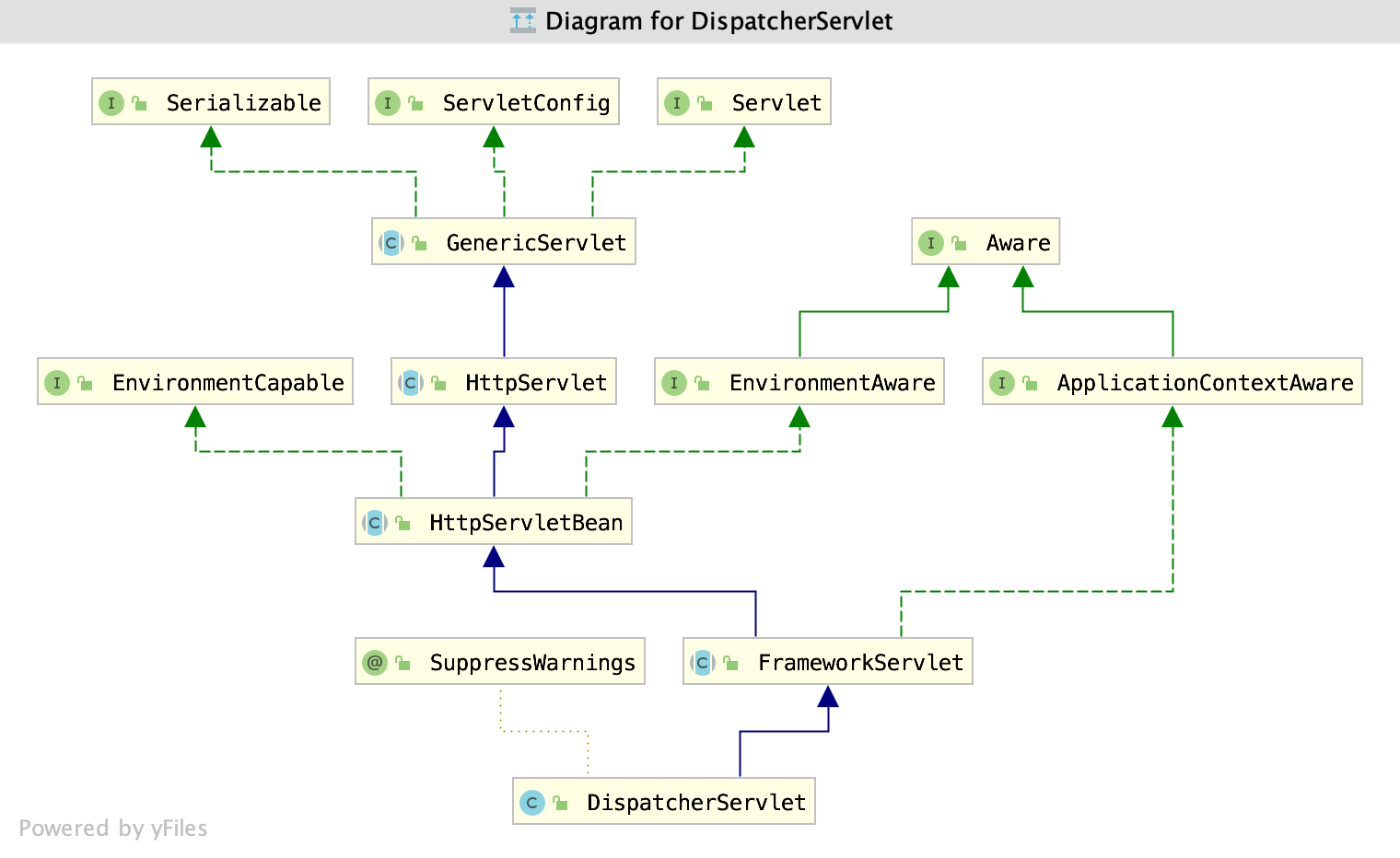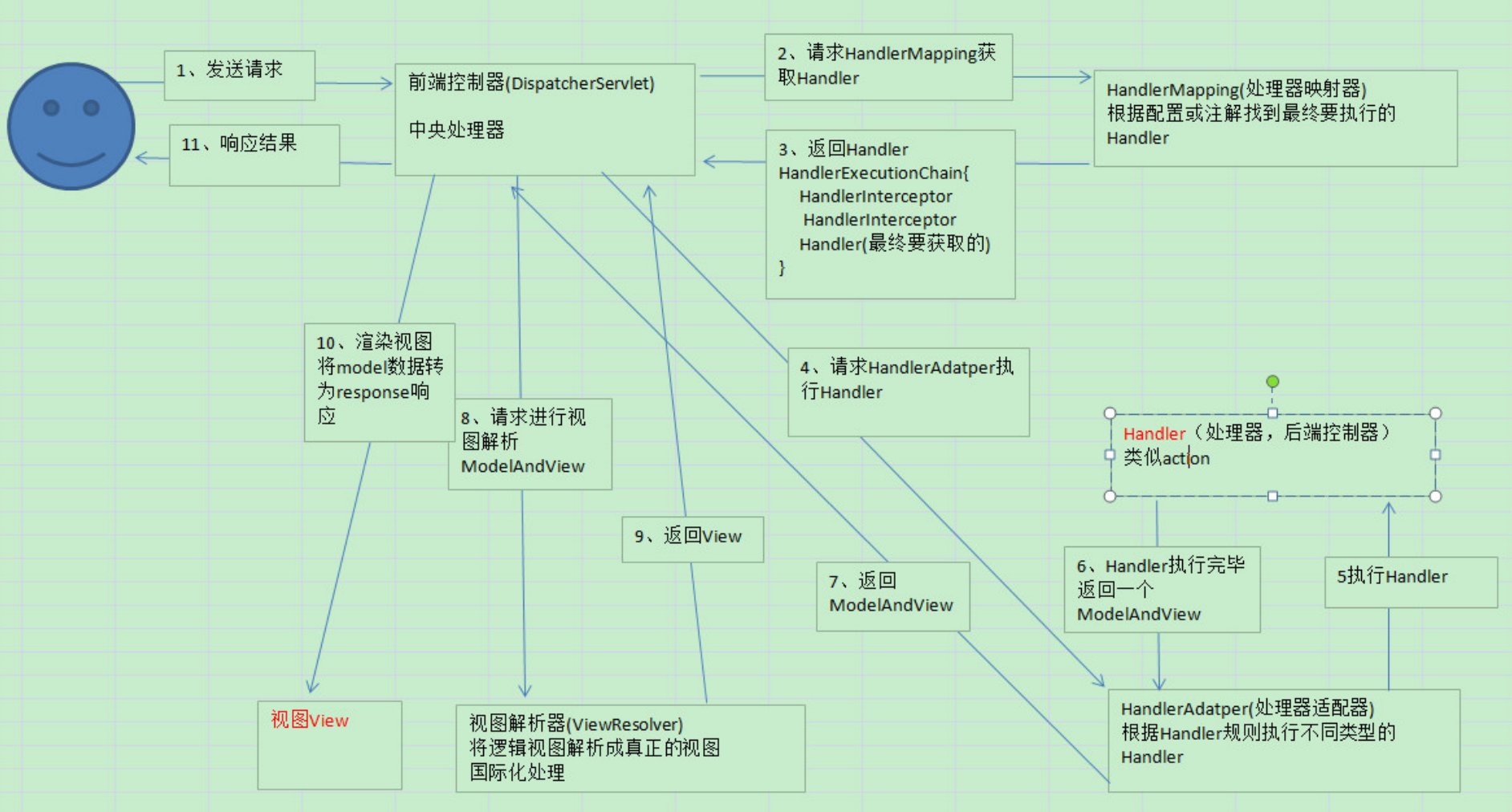本章是整理知识内容,为强化知识长期更新。
Spring Web MVC
Spring Web 模型-视图-控制器 (MVC) 框架围绕
DispatcherServlet将请求分派给处理程序而设计。
常用注解
@Controller
- 声明在类上,该注解表明该类扮演控制器的角色,类似Action。
@RestController
- RestController是Controller超子集,相当于@RequestMapping方法默认采用@ResponseBody注解。
@RequestMapping
- 该注解是用来映射一个URL到一个类或一个特定的方处理法上。
- RequestMapping属性
- path / method 指定方法的映射路径
- params / headers 请求映射范围
- consumes / produces 请求与响应格式的限制范围
- Restfull风格的使用。
- restfull 支持的请求头GET, HEAD, POST, PUT, PATCH, DELETE, OPTIONS, TRACE 。
- 通常情况下只使用 GET,PUT,POST,DELETE。
- GET 通常用来获取数据。
- PUT 通常用来新增数据。
- POST 通常用来更新数据。
- DELETE 通常用来删除数据。
1
2
3
4
5
6
7
8
9
10
11
12
13
14
15
16
17
18
19
public Object get(){
return "200";
}
public Object post(){
return "200";
}
public Object delete(){
return "200";
}
public Object put(){
return "200";
}
DispatcherServlet
- Root WebApplicationcontext 是可以在不同的 Servlet WebApplicationcontext共享,但是反来不醒,因此通常将web相关的代码放到Servlet WebApplicationcontext一些基础代码放到Root WebApplicationcontext 。也可以让Root WebApplicationcontext 托管所有的bean,这样可以避免Servlet WebApplicationcontext未初始化全部bean的问题。
源码分析
DispatcherServlet是继承了FrameworkServlet,而FrameworkServlet又继承了HttpServletBean。追溯到最上层其实就是Servlet。通过源码可以发现最核心的一个方法
doService()。处理流程
1 | /** |
Spring作用域。
当定义一个Bean时,可以给这个Bean声明一个作用域。通过@Scope注解声明在类上。
- Bean默认作用域是singleton 单例模式,在每个Spring Ioc容器中的一个Bean定义一个实例,也就是无状态Bean,也就是线程不安全的。这个单一实例会被存储到单例缓存(singleton cache)中,并且所有针对该bean的后续请求、访问和引用都将返回被缓存的对象实例。相当于一次创建多次使用。
- prototype 原型模式,在每个Spring Ioc容器中的一个Bean定义多实例,就相当与Java 中new 操作。通常作为有状态的Bean。Prototype作用域的bean会导致在每次对该bean请求(将其注入到另一个bean中,或者以程序的方式调用容器的getBean()方法)时都会创建一个新的bean实例。
spring mvc增加的作用域。
- request、session、global session 仅在基于web的应用中使用(不必关心你所采用的是什么web应用框架)。
- 如果不是在web下实现而是通过ApplicationContext这种实现,尝试使用这些作用域将抛出异常IllegalStateException未知作用域。
- request 对每一次HTTP请求都会产生一个新的bean。Spring容器会根据loginAction bean定义创建一个全新的LoginAction bean实例,且该loginAction bean实例仅在当前HTTP request内有效,因此可以根据需要放心的更改所建实例的内部状态,而其他请求中根据loginAction bean定义创建的实例,将不会看到这些特定于某个请求的状态变化。当处理请求结束,request作用域的bean实例将被销毁。
- session 对每一次HTTP请求都会产生一个新的bean,Spring容器会根据userPreferences bean定义创建一个全新的userPreferences bean实例,且该userPreferences bean仅在当前HTTP Session内有效。与request作用域一样,你可以根据需要放心的更改所创建实例的内部状态,而别的HTTP Session中根据userPreferences创建的实例,将不会看到这些特定于某个HTTP Session的状态变化。当HTTP Session最终被废弃的时候,在该HTTP Session作用域内的bean也会被废弃掉。
- global session 作用域类似于标准的HTTP Session作用域,不过它仅仅在基于portlet的web应用中才有意义。Portlet规范定义了全局Session的概念,它被所有构成某个portlet web应用的各种不同的portlet所共享。在global session作用域中定义的bean被限定于全局portlet Session的生命周期范围内。在一个标准的基于Servlet的web应用,并且定义了一个或多个具有global session作用域的bean,系统会使用标准的HTTP Session作用域,并且不会引起任何错误。
- 作用域依赖
- Spring IoC容器除了管理对象(bean)的实例化,同时还负责协作者(或者叫依赖)的实例化。如果将一个Http request范围的bean注入到另一个bean中,那么需要注入一个AOP代理来替代被注入的作用域bean。也就是说需要注入一个代理对象,该对象具有与被代理对象一样的公共接口,而容器则可以足够智能的从相关作用域中(比如一个HTTP request)获取到真实的目标对象,并把方法调用委派给实际的对象。
- request、session、global session 仅在基于web的应用中使用(不必关心你所采用的是什么web应用框架)。
内嵌web容器
spring boot 可以切换web容器,通过spring boot spi机制,引入不同的web容器并屏蔽默认tomcat完成切换web容器。
- spring-boot-starter-tomcat
- Spring-boot-starter-jettty
- Spring-boot-starter-undertow
- spring-boot-starter-reactor-netty
web配置
web容器配置信息分为两种,配置文件和代码配置。这里主要说下代码配置。
- WebServerFactoryCustomizer
- TomcatServletWebServerFactory
- JettyServletWebServerFactory
- UndertowServletWebServerFactory
扩展
- 重定向,在spring mvc中有一个重定向视图(很少用)
- Redirect: 做了一个http 302的跳转,由客户端发起。(会丢失上一次请求的请求头)
- Forward: 由服务端发起的跳转。


